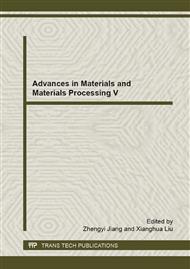p.155
p.160
p.164
p.168
p.175
p.180
p.184
p.188
p.193
Micromechanics Analysis of Elastic Modulus of Alumina-Carbon Refractories
Abstract:
Based on the micromechanics theory, Alumina-carbon refractories were regarded as resin-carbon bonded composites, including alumina, graphite and pores derived from particles packing gaps and phenolic resin pyrolysis. Graphite was regarded as isotropic spherical inclusions; particles packing gaps and phenolic resin pyrolysis pores were regarded as pore phase all together. Applying Mori-Tanaka multi-phase spherical inclusion method, firstly, elastic constants of resin-carbon phase were computed reversely by the elastic constants known alumina-carbon refractories, alumina and graphite, and then the effective elastic modulus of alumina-carbon refractories were estimated by the calculated elastic constants of resin-carbon and other raw materials. The results show that: the predicted elastic modulus by Mori-Tanaka model are higher than the experimental measurement values; resin carbon residue and pores have a great influence on effective elastic modulus of alumina-carbon refractories.
Info:
Periodical:
Pages:
175-179
Citation:
Online since:
March 2015
Authors:
Keywords:
Price:
Сopyright:
© 2015 Trans Tech Publications Ltd. All Rights Reserved
Share:
Citation:


